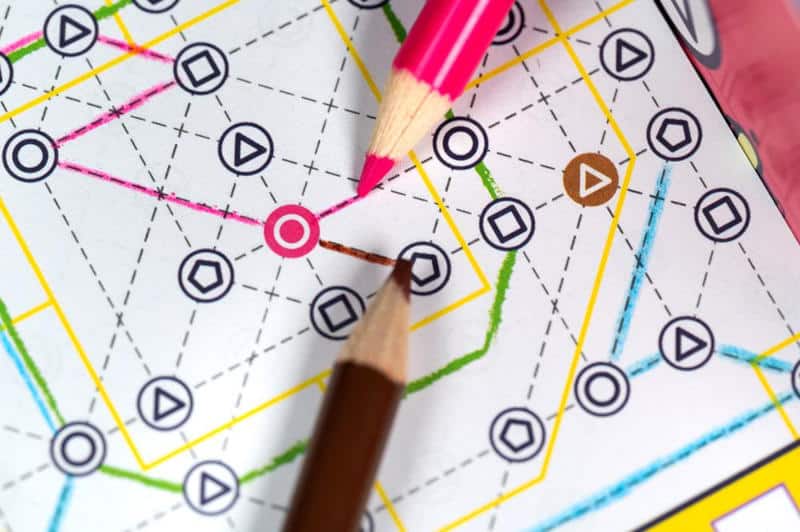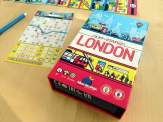| Release Date: 2023 | Players: 1-4 |
| Designer: Matthew Dunstan | Length: 30-45 minutes |
| Artist: Maxime Morin | Age: 8+ |
| Publisher: Blue Orange Games | Complexity: 1.5 / 5 |
| Plastic (by weight): <1% | Air (by volume): <10% |
We were on our way to the city’s main station to board the bullet train to Kyoto. Travelling on the Asakusa underground line towards Ikebukuro, we had just passed through Kasumigaseki and arrived at Ginza station. We were nearly there. It was Next Station: Tokyo by Matthew Dunstan from Blue Orange.
Listen to the Audio Version
Intro Music: Bomber (Sting) by Riot (https://www.
Sound Effects: bbc.co.uk – © copyright 2024 BBC
Music: I Feel It (instrumental) by Sascha Ende
Website: https://filmmusic.
Licensed under CC BY 4.0: https://filmmusic.
The Same but Different
Just like London buses, underground networks also come in twos. After the success of Next Station: London, there is now another game in this wonderful flip-and-write series. Next Station: Tokyo is very similar to its predecessor, which is to be expected. You have the usual pad of tube maps, with stations represented by one of the four different shapes and pre-printed dotted lines that you follow to draw your network. The Tokyo map also has the familiar districts which are outlined by yellow borders. The gameplay is also very similar. You shuffle the deck of cards, flip over the top one and then draw a line between the relevant stops.
Of course, both games are not exactly the same. Not only is the layout of the stations and districts different, but in Next Station: Tokyo, there is a whole tube line preprinted. This green circle line is an interesting addition. It already connects certain stations and counts towards the bonus points of having stations connected by multiple lines. Additionally, when a certain card is flipped over, you are allowed to continue your current line in parallel to the green circle line, provided one of the ends of your current line is on the circle.
There is more though. The way interchange stations score has also changed. You no longer get points for stations serviced by two different coloured lines. The minimum is three, which is easier because of the existing green circle line. Additionally, if you can create an interchange station with at least two different coloured lines in one of the outer districts, you can score additional points. The game is trying to incentivise you to make the suburbs better connected, which is a lot harder to achieve than you might imagine.
Tokyo is Busy
Finally, the river has gone. That might be a little surprising, because Tokyo does have waterways, but maybe the map would have been too busy if they had all been added. In fact, Next Station: Tokyo has enough going on without having to worry about crossing rivers as well.
So even though, on the face of it, there isn’t actually that much difference between Tokyo and London, the devil is in the details. I was really surprised at how much you have to think about when you play the latest game in the series. While playing London usually feels quite intuitive, without having to worry too much about which direction to take, Tokyo does make your brain explode.

You want to have interchange stations in the outer districts, but unless you can bring three different lines to the same stop, you don’t get additional points for the interchange itself. If you focus on connecting to the green circle, you get the interchange bonuses, but not the outer district ones. You also want to be on the green circle line, so you can run your track in parallel, but of course, the right card never comes up when you need it. Oh, and I forgot to mention, any station on the green line that you don’t connect up with a second colour will give you negative points. So, yes, you definitely want to be in the centre, but also on the outskirts, even though you don’t necessarily need to get right into the corners, but if you do, you could score lots of points, but then you might lose points for the green circle line and… and… wow!
There really is a lot to think about. Every time a new card is flipped over, you need to consider your options and decide if you need to abandon your plans and try and minimise your losses or if you can still risk it to get a large bonus.
Tokyo to London
Now while I love both games, I do so for different reasons. If you want a lighter experience with family on a lazy Sunday afternoon, London is probably your safer bet. If you fancy a bit of a brain burner that will take a little longer to play and might see you cursing your decision two turns ago, then Tokyo is the perfect fit. Some people might say that if you have one of the two games in the series, you don’t need the other. However, I feel you want both. That way you can choose the right one depending on what state your brain is in.
Also, here is a little secret tip for you. If you want to try out London or Tokyo, the maps and rulebook are available to download from the publisher’s website. So you can give them both a go and see how you fare. Maybe one of the two is the better option for you. Maybe you find they both scratch different itches. Whatever you find though, both games are a wonderful way of rediscovering your inner child and having fun with all the family.
So, off to your Next Station: Tokyo you go!
Keeping the blog running takes time and resources. So if you can chip in, that would be amazing.
Useful Links
- Next Station: Tokyo: https://blueorangegames.
eu/ en/ games/ next-station-tokyo/ - Rulebook: https://blueorangegames.
eu/ wp-content/ uploads/ 2023/ 05/ NextStationTokyo-Rules-EN. pdf - Blue Orange: https://blueorangegames.
eu/ en/ - BGG listing: https://boardgamegeek.
com/ boardgame/ 380165/ next-station-tokyo - Next Station: London review: https://tabletopgamesblog.
com/ 2023/ 06/ 17/ next-station-london-saturday-review/
Transparency Facts
I feel that this review reflects my own, independent and honest opinion, but the facts below allow you to decide whether you think that I was influenced in any way. Please also read my Ethics Statement for more information.- I played a friend's copy of the game.
- At the time of writing, I have not received financial support from the publisher or anyone working on their behalf.
Audio Version
Intro Music: Bomber (Sting) by Riot (https://www.
Sound Effects: bbc.co.uk – © copyright 2024 BBC
Music: I Feel It (instrumental) by Sascha Ende
Website: https://filmmusic.
Licensed under CC BY 4.0: https://filmmusic.
Playlist
These are the songs I listened to while I was writing this review:






